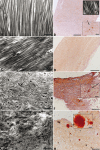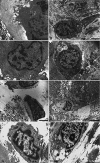Morphological and ultrastructural analysis of normal, injured and osteoarthritic human knee menisci
- PMID: 30739432
- PMCID: PMC6379780
- DOI: 10.4081/ejh.2019.2998
Morphological and ultrastructural analysis of normal, injured and osteoarthritic human knee menisci
Abstract
The human meniscus plays a crucial role for transmission and distribution of load across the knee, as well as shock absorption, joint stability, lubrication, and congruity. The aim of this study was to compare the complex geometry, and unique ultrastructure and tissue composition of the meniscus in healthy (control) and pathological conditions to provide understanding of structural changes that could be helpful in the future design of targetted therapies and improvement of treatment indications. We analyzed meniscus samples collected from 3 healthy multi-organ donors (median age, 66 years), 5 patients with traumatic meniscal tear (median age, 41 years) and 3 patients undergoing total knee replacement (TKR) for end-stage osteoarthritis (OA) (median age, 72 years). We evaluated the extracellular matrix (ECM) organization, the appearance and distribution of areas of calcification, and modifications of cellular organization and structure by electron microscopy and histology. The ECM structure was similar in specimens from traumatic meniscus tears compared to those from patients with late-stage OA, showing disorganization of collagen fibers and increased proteoglycan content. Cells of healthy menisci showed mainly diffuse chromatin and well preserved organelles. Both in traumatic and in OA menisci, we observed increased chromatin condensation, organelle degeneration, and cytoplasmic vacuolization, a portion of which contained markers of autophagic vacuoles. Areas of calcification were also observed in both traumatic and OA menisci, as well as apoptotic-like features that were particularly prominent in traumatic meniscal tear samples. We conclude that meniscal tissue from patients with traumatic meniscal injury demonstrate pathological alterations characteristic of tissue from older patients undergoing TKR, suggesting that they have high susceptibility to develop OA.
Conflict of interest statement
Conflict of interest: The authors report no conflicts of interest related to any aspects of the presented manuscript. The authors alone are responsible for the content and writing of the article.
Figures




References
-
- Hunter DJ, Zhang YQ, Niu JB, Tu X, Amin S, Clancy M, et al. The association of meniscal pathologic changes with cartilage loss in symptomatic knee osteoarthritis. Arthritis Rheum 2006; 54:795-801. - PubMed
-
- Ding C, Martel-Pelletier J, Pelletier JP, Abram F, Raynauld JP, Cicuttini F, et al. Meniscal tear as an osteoarthritis risk factor in a largely non-osteoarthritic cohort: a cross-sectional study. J Rheumatol 2007;34:776-84. - PubMed
-
- Englund M, Roos EM, Lohmander LS. Impact of type of meniscal tear on radiographic and symptomatic knee osteoarthritis: a sixteen-year followup of meniscectomy with matched controls. Arthritis Rheum 2003;48:2178-87. - PubMed
MeSH terms
LinkOut - more resources
Full Text Sources
Medical

